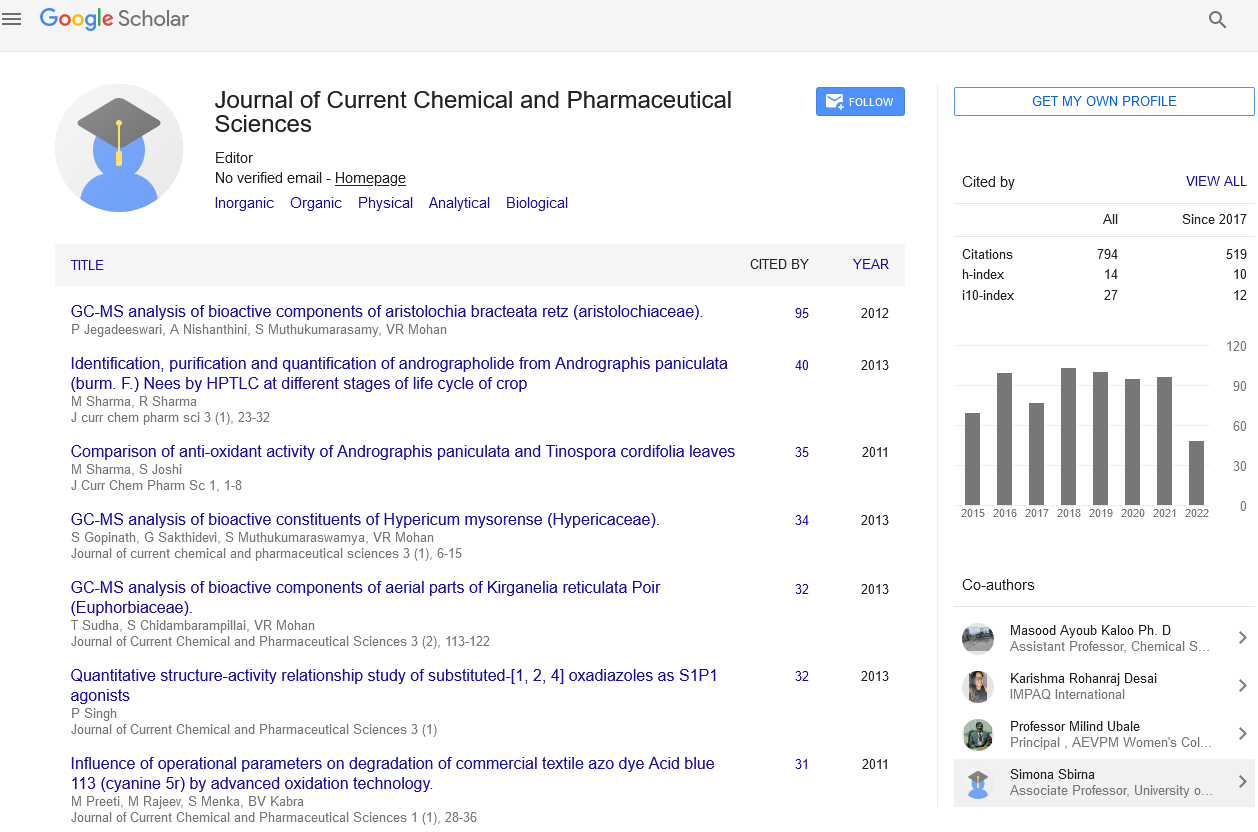Editorial
, Volume: 10( 2) DOI: 10.37532/2277-2871.2020.10(2).e101Chronicles of a chemical chart
- *Correspondence:
- Masood Ayoub Kaloo Department of Chemistry, Government Degree College, Shopian, Jammu and Kashmir, India, E-mail: makandchem@gmail.com
Received: April 06, 2020; Accepted: April 16, 2020; Published: April 30, 2020
Citation: Masood AK, Chronicles of a Chemical Chart, J Curr Chem Pharm Sc. 2019; 10(1): e101.
Abstract
Being one among the article board individuals, I take a benefit to talk about the Journal of Current Chemical and Pharmaceutical Sciences as it covers the diverse sections/ fields related to the theory and practice of Inorganic, Organic, Physical, Analytical, Biological, Pharmaceutical, Industrial, Environmental, Agro and Soil Chemistry as well as Chemical Physics and Engineering
To The Editor
Being one among the article board individuals, I take a benefit to talk about the Journal of Current Chemical and Pharmaceutical Sciences as it covers the diverse sections/ fields related to the theory and practice of Inorganic, Organic, Physical, Analytical, Biological, Pharmaceutical, Industrial, Environmental, Agro and Soil Chemistry as well as Chemical Physics and Engineering.
As the International Year of the Periodic Table draws to an end, we reflect on how it has prompted chemists to explore the past, present and future of this chemical icon.
Chemists especially those active on social media would have been hard pressed not to notice that 2019 was the International Year of the Periodic Table (IYPT), marking the 150th anniversary of Dmitri Mendeleev’s early arrangement of the then known elements. One of the aims of this yearlong celebration is to raise the profile of chemistry with the wider public and better explain its importance in particular for global challenges related to human health and sustainable development. The IYPT has also prompted many chemists to take a closer look at the table, from a variety of different angles, and share what they have learned; the pieces we have published on this topic periodically throughout the year are gathered together in a collection As chemistry has evolved over the past century and a half, so has the periodic table. The discovery of new elements combined with a deeper understanding of their properties and how they relate to each other has seen this iconic chart go through a number of iterations to arrive at the standard version we know today. And it hasn’t just been a simple case of plugging gaps as new elements were found in nature or created in the lab; some proposed entries turned out not to be elements after all and their coveted place at the table had to be given up. In a Comment article published early in the IYPT. Journal of Current chemical and Pharmaceutical sciences is a high visibility and quality journal, publishing rigorously peer-reviewed Journal.
Early developments in the table are, understandably, not as well documented as more recent ones and we’re still learning new things about its history. This is nicely illustrated by the ‘tale of two tables’ from the late 1880s (or thereabouts), recounted by Pilar Gil and Eli Zysman-Colman in a Thesis article. After an old periodic table was discovered at the University of St Andrews, some detective work involving the university’s archives and financial records from the late 19th century suggests that it is currently the earliest known example of a classroom wallchart. Meanwhile, analysis of a different table printed in French but found in the German city of Koblenz is a “testimony to turbulent times in the past” — including the periods of French occupation that the city went through after both World Wars.
